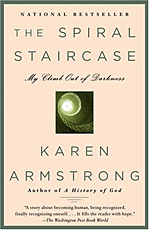Book review
The Spiral Staircase
by
Karen Armstrong   Â
Harper
Perennial 2005
 If you're interested in stories
about church leavers, this one is more dramatic than most. In 1962, at the age
of 17, Karen Armstrong became a Roman Catholic nun. Seven years later she left
the convent and re-entered a world that had changed dramatically. In this book
she tells the story of that re-entry. (The account of her time as a nun is
given in an earlier book Through the
Narrow Gate, published by Harper Collins.)Â
It's beautifully written, moving, entertaining, and ultimately hopeful.
If you're interested in stories
about church leavers, this one is more dramatic than most. In 1962, at the age
of 17, Karen Armstrong became a Roman Catholic nun. Seven years later she left
the convent and re-entered a world that had changed dramatically. In this book
she tells the story of that re-entry. (The account of her time as a nun is
given in an earlier book Through the
Narrow Gate, published by Harper Collins.)Â
It's beautifully written, moving, entertaining, and ultimately hopeful.
In her seven years in the convent
Karen had done her uttermost to ‘die to self' – to become the perfect nun. She
left because for all her longing and trying she simply could not conform to
that ideal. She had entered because she longed to find God. She left because in
the end, God simply did not turn up. She saw herself as the failure, rather
than God or the monastic ideal.
Karen describes a culture shock
beyond most people's experience. Far from plunging happily into the new life of
freedom as people expected, she was disoriented, confused, and homesick even
for the routines and the beauty of some aspects of convent life. To make things
even more difficult for her she suffered panic attacks and seizures. Her doctor
and psychologist insisted on treating these as mental problems. Not for some
years was the real cause traced: she has epilepsy.
Adolescence and the early 20s are
the years in which most of us begin to discover who we are – what we like and
dislike, our talents and weaknesses. But these were the very years in which
Karen Armstrong was doing her best to cooperate with a system designed to
eliminate all individuality and enforce perfect conformity. Thus the book tells
of her struggles and experiments to find out who she was and what she might do
with her life. A gifted scholar, she recovered the ability to think critically,
but failed to become an academic because her doctoral thesis was not accepted.
Instead she became a teacher, and later made television
documentaries for the BBC. She is now a best selling author writing about
aspects of faith and history.
For me the most absorbing
aspect of the book is Karen's reflections about faith and belief – the inner
journey. She continued to practice as a Catholic for a time after she left the
convent but eventually admitted with relief that it had no meaning for her. She
describes how it had been:
“I had wanted to be filled with God, transformed by a
holiness that would bring me a fuller and more satisfying existence. But
instead I had starved my mind and myÂ
heart, and that hunger had atrophied, died, and been replaced by a
malaise with all things religious. And yet … I felt nostalgia for what I had
once been.”
That ‘and yet' continues
to be expressed in Karen's life. She is often asked whether she ‘believes in
God'. That, she says, is not a proper question, not an answerable question. In
her study of the three Abrahamic faiths she came to realise that theology is
not a science but an art, a species of poetry, not about assent to
propositions, but about being receptive to elusive truth. In study she found
‘mini-seconds of transcendence, awe and wonder ….the ecstasy that I had hoped
to find in hours of prayer.'
The proper question for Karen is not
the explicit content of what we may believe about ‘God' or ‘the sacred' but the
effect that faith has in our lives. Does it lead to practical compassion?
Compassion – feeling with – is the pivotal, essential virtue.
She ends the book with
her sense of having come full circle.
“I tried to break away from the convent but I still live
alone, spend my days in silence and am almost wholly occupied in writing,
thinking and speaking about God and spirituality.”
This is a book to own and
re-read.
Adrienne Thompson
